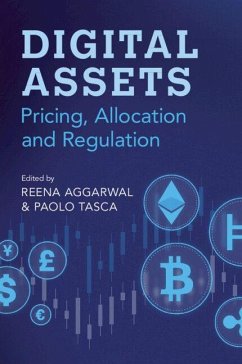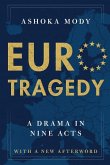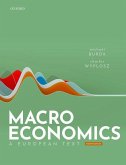Digital Assets
Herausgeber: Aggarwal, Reena; Tasca, Paolo
Digital Assets
Herausgeber: Aggarwal, Reena; Tasca, Paolo
- Broschiertes Buch
- Merkliste
- Auf die Merkliste
- Bewerten Bewerten
- Teilen
- Produkt teilen
- Produkterinnerung
- Produkterinnerung
The book deepens our understanding of the complex inter-relations between traditional and digital assets. The first of its kind to present a comprehensive review of studies on valuation and pricing of digital assets in general, it introduces new models of portfolio strategies with digital assets.
Andere Kunden interessierten sich auch für
![Narrative Economics Narrative Economics]() Robert J. ShillerNarrative Economics26,99 €
Robert J. ShillerNarrative Economics26,99 €![Economics After the Crisis Economics After the Crisis]() Irene van StaverenEconomics After the Crisis79,99 €
Irene van StaverenEconomics After the Crisis79,99 €![John Maynard Keynes John Maynard Keynes]() Hyman MinskyJohn Maynard Keynes25,99 €
Hyman MinskyJohn Maynard Keynes25,99 €![Eurotragedy Eurotragedy]() Ashoka Mody (Charles and Marie Robertson Visiting Professor in InteEurotragedy37,99 €
Ashoka Mody (Charles and Marie Robertson Visiting Professor in InteEurotragedy37,99 €![Macroeconomics Macroeconomics]() Michael Burda (Humboldt University, Berlin, Humboldt University, BeMacroeconomics65,99 €
Michael Burda (Humboldt University, Berlin, Humboldt University, BeMacroeconomics65,99 €![Macroeconomics (International Edition) Macroeconomics (International Edition)]() N. Gregory MankiwMacroeconomics (International Edition)95,99 €
N. Gregory MankiwMacroeconomics (International Edition)95,99 €![Extreme Economies Extreme Economies]() Richard DaviesExtreme Economies19,99 €
Richard DaviesExtreme Economies19,99 €-
-
-
The book deepens our understanding of the complex inter-relations between traditional and digital assets. The first of its kind to present a comprehensive review of studies on valuation and pricing of digital assets in general, it introduces new models of portfolio strategies with digital assets.
Produktdetails
- Produktdetails
- Verlag: Cambridge University Press
- Seitenzahl: 312
- Erscheinungstermin: 10. Februar 2025
- Englisch
- Abmessung: 229mm x 152mm x 17mm
- Gewicht: 460g
- ISBN-13: 9781009362306
- ISBN-10: 1009362305
- Artikelnr.: 69869757
- Herstellerkennzeichnung
- Libri GmbH
- Europaallee 1
- 36244 Bad Hersfeld
- gpsr@libri.de
- Verlag: Cambridge University Press
- Seitenzahl: 312
- Erscheinungstermin: 10. Februar 2025
- Englisch
- Abmessung: 229mm x 152mm x 17mm
- Gewicht: 460g
- ISBN-13: 9781009362306
- ISBN-10: 1009362305
- Artikelnr.: 69869757
- Herstellerkennzeichnung
- Libri GmbH
- Europaallee 1
- 36244 Bad Hersfeld
- gpsr@libri.de
Part I. Institutionalization of Digital Assets: 1. Institutionalization of
digital assets Reena Aggarwal and Chris Matturri; 2. How and when are
cryptocurrency predictable? Back-testing their portfolio economic value
Massimo Guidolin and Manuela Pedio; 3. DeFi vs TradFi: valuation using
multiples and discounted cash flows Teng Andrea Xu, Jiahua Xu and Kristof
Lommers; Part II. Digital Assets and Decentralised Finance: 4. The
suitability of securities token offerings, cryptocurrencies, and
crypto-related assets for pension investments John A. Turner; 5. Regulatory
considerations on the decentralised financial system Ryosuke Ushida and
Shin'ichiro Matsuo; 6. A hayekian view of digital currencies Andy Yee and
Nikhil Vadgama; Part III. Regulations and Compliance of Digital Assets: 7.
Call for a global cryptoassets regulatory framework: lessons from the US,
Europe, and the UK Giovanna Massarotto; 8. Privacy coins and the reasonable
expectation of privacy: evaluating the efficacy of national security
letters Wanjiku Karanja; 9. UK anti-money laundering regulation of
cryptoassets Pierre Ostercamp; 10. Triple-entry accounting, blockchain and
next of kin: towards a stan-dardization of ledger terminology Juan Ignacio
Ibanez, Chris N. Bayer, Paolo Tasca and Jiahua Xu; Part IV. Cryptocurrency
Economics and Monetary Policies: 11. Monetary policy in a world with
cryptocurrencies, stablecoins and CBDC Daniel Heller; 12. Yields: the
galapagos syndrome of cryptofinance Bernhard K. Meister and Henry C. W.
Price; 13. The 'klair effect': a new monetary framework on controlling
inflation using CBDC Sarbjit Klair.
digital assets Reena Aggarwal and Chris Matturri; 2. How and when are
cryptocurrency predictable? Back-testing their portfolio economic value
Massimo Guidolin and Manuela Pedio; 3. DeFi vs TradFi: valuation using
multiples and discounted cash flows Teng Andrea Xu, Jiahua Xu and Kristof
Lommers; Part II. Digital Assets and Decentralised Finance: 4. The
suitability of securities token offerings, cryptocurrencies, and
crypto-related assets for pension investments John A. Turner; 5. Regulatory
considerations on the decentralised financial system Ryosuke Ushida and
Shin'ichiro Matsuo; 6. A hayekian view of digital currencies Andy Yee and
Nikhil Vadgama; Part III. Regulations and Compliance of Digital Assets: 7.
Call for a global cryptoassets regulatory framework: lessons from the US,
Europe, and the UK Giovanna Massarotto; 8. Privacy coins and the reasonable
expectation of privacy: evaluating the efficacy of national security
letters Wanjiku Karanja; 9. UK anti-money laundering regulation of
cryptoassets Pierre Ostercamp; 10. Triple-entry accounting, blockchain and
next of kin: towards a stan-dardization of ledger terminology Juan Ignacio
Ibanez, Chris N. Bayer, Paolo Tasca and Jiahua Xu; Part IV. Cryptocurrency
Economics and Monetary Policies: 11. Monetary policy in a world with
cryptocurrencies, stablecoins and CBDC Daniel Heller; 12. Yields: the
galapagos syndrome of cryptofinance Bernhard K. Meister and Henry C. W.
Price; 13. The 'klair effect': a new monetary framework on controlling
inflation using CBDC Sarbjit Klair.
Part I. Institutionalization of Digital Assets: 1. Institutionalization of
digital assets Reena Aggarwal and Chris Matturri; 2. How and when are
cryptocurrency predictable? Back-testing their portfolio economic value
Massimo Guidolin and Manuela Pedio; 3. DeFi vs TradFi: valuation using
multiples and discounted cash flows Teng Andrea Xu, Jiahua Xu and Kristof
Lommers; Part II. Digital Assets and Decentralised Finance: 4. The
suitability of securities token offerings, cryptocurrencies, and
crypto-related assets for pension investments John A. Turner; 5. Regulatory
considerations on the decentralised financial system Ryosuke Ushida and
Shin'ichiro Matsuo; 6. A hayekian view of digital currencies Andy Yee and
Nikhil Vadgama; Part III. Regulations and Compliance of Digital Assets: 7.
Call for a global cryptoassets regulatory framework: lessons from the US,
Europe, and the UK Giovanna Massarotto; 8. Privacy coins and the reasonable
expectation of privacy: evaluating the efficacy of national security
letters Wanjiku Karanja; 9. UK anti-money laundering regulation of
cryptoassets Pierre Ostercamp; 10. Triple-entry accounting, blockchain and
next of kin: towards a stan-dardization of ledger terminology Juan Ignacio
Ibanez, Chris N. Bayer, Paolo Tasca and Jiahua Xu; Part IV. Cryptocurrency
Economics and Monetary Policies: 11. Monetary policy in a world with
cryptocurrencies, stablecoins and CBDC Daniel Heller; 12. Yields: the
galapagos syndrome of cryptofinance Bernhard K. Meister and Henry C. W.
Price; 13. The 'klair effect': a new monetary framework on controlling
inflation using CBDC Sarbjit Klair.
digital assets Reena Aggarwal and Chris Matturri; 2. How and when are
cryptocurrency predictable? Back-testing their portfolio economic value
Massimo Guidolin and Manuela Pedio; 3. DeFi vs TradFi: valuation using
multiples and discounted cash flows Teng Andrea Xu, Jiahua Xu and Kristof
Lommers; Part II. Digital Assets and Decentralised Finance: 4. The
suitability of securities token offerings, cryptocurrencies, and
crypto-related assets for pension investments John A. Turner; 5. Regulatory
considerations on the decentralised financial system Ryosuke Ushida and
Shin'ichiro Matsuo; 6. A hayekian view of digital currencies Andy Yee and
Nikhil Vadgama; Part III. Regulations and Compliance of Digital Assets: 7.
Call for a global cryptoassets regulatory framework: lessons from the US,
Europe, and the UK Giovanna Massarotto; 8. Privacy coins and the reasonable
expectation of privacy: evaluating the efficacy of national security
letters Wanjiku Karanja; 9. UK anti-money laundering regulation of
cryptoassets Pierre Ostercamp; 10. Triple-entry accounting, blockchain and
next of kin: towards a stan-dardization of ledger terminology Juan Ignacio
Ibanez, Chris N. Bayer, Paolo Tasca and Jiahua Xu; Part IV. Cryptocurrency
Economics and Monetary Policies: 11. Monetary policy in a world with
cryptocurrencies, stablecoins and CBDC Daniel Heller; 12. Yields: the
galapagos syndrome of cryptofinance Bernhard K. Meister and Henry C. W.
Price; 13. The 'klair effect': a new monetary framework on controlling
inflation using CBDC Sarbjit Klair.









